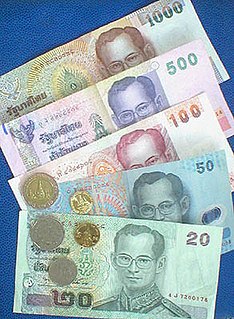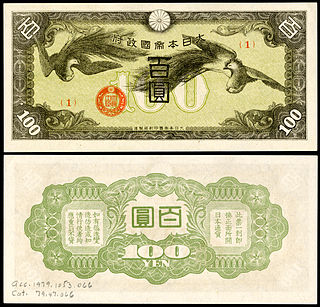A single banknote was issued by the Indian Princely State of Ambliara. It is undated. It is also a very rare note.
Contents


A single banknote was issued by the Indian Princely State of Ambliara. It is undated. It is also a very rare note.


PS201. 1 paisa (1 pice). ND. Black text on brown pressboard.

The Bank of England is the central bank of the United Kingdom and the model on which most modern central banks have been based. Established in 1694 to act as the English Government's banker, and still one of the bankers for the Government of the United Kingdom, it is the world's eighth-oldest bank. It was privately owned by stockholders from its foundation in 1694 until it was nationalised in 1946.

Baht is the official currency of Thailand. It is subdivided into 100 satang. The issuance of currency is the responsibility of the Bank of Thailand.

The dinar, the principal currency unit in several countries, was used historically in several more.
A pre-money valuation is a term widely used in private equity or venture capital industries, referring to the valuation of a company or asset prior to an investment or financing. If an investment adds cash to a company, the company will have different valuations before and after the investment. The pre-money valuation refers to the company's valuation before the investment.

The Pakistani Rupee (Urdu: روپیه / ALA-LC: Rūpiyah; sign: ₨; code: abbreviated as PKR, is the official currency of Pakistan since 1948.

The birr is the unit of currency in Ethiopia. Before 1976, dollar was the official English translation of birr. Today, it is officially birr in English as well.
McConnell v. Federal Election Commission, 540 U.S. 93 (2003), is a case in which the United States Supreme Court upheld the constitutionality of most of the Bipartisan Campaign Reform Act (BCRA), often referred to as the McCain–Feingold Act.

Government debt, also known as public interest, public debt, national debt and sovereign debt, contrasts to the annual government budget deficit, which is a flow variable that equals the difference between government receipts and spending in a single year. The debt is a stock variable, measured at a specific point in time, and it is the accumulation of all prior deficits.

Japanese military yen, commonly abbreviated as JMY, was the currency issued to the soldiers of the Imperial Japanese Army and the Imperial Japanese Navy as a salary. The Imperial Japanese government first started issuing the military yen during the Russo-Japanese War in 1904. The military yen reached its peak during the Pacific War period, when the Japanese government excessively issued it to all of its occupied territories. In Hong Kong, the military yen was forced upon the local population as the sole official currency of the territory. Since the military yen was not backed by gold, and did not have a specific place of issuance, the military yen could not be exchanged for the Japanese yen. Forcing local populations to use the military yen officially was one of the ways the Japanese government could dominate the local economies.

Jalor, also known as granite city, is a city in Rajasthan state of western India. It is the administrative headquarters of Jalore District.

Mahi Kantha was a political agency or collection of princely states in British India, within the Gujarat Division of Bombay Presidency. In 1933, the states of the Mahi Kantha Agency, except for Danta, were included in the Western India States Agency. The total area of the agency was 8,094 km2 (3,125 sq mi); the population in 1901 was 361,545.

Early American currency went through several stages of development during the colonial and post-Revolutionary history of the United States. Because few coins were minted in the thirteen colonies that became the United States, foreign coins like the Spanish dollar were widely circulated. Colonial governments sometimes issued paper money to facilitate economic activities. The British Parliament passed Currency Acts in 1751, 1764, and 1773 that regulated colonial paper money.
Songara or Songira is the name of a branch of the Chauhan clan of Rajputs. Several dynasties belonging to this clan ruled small kingdoms and principalities in medieval India. These include the Chahamanas of Jalor, and the rulers of the Ambliara State. The Deora ruling family of the Sirohi State was also descended from the Chahamanas of Jalor. The Songara rulers of Sikar and Shekhawati were the descendants of Chahamanas of Sirohi. 1380-1614 as rulers of Sikar and 1614-1948 as rulers of Shekhawati.
The island of Alderney has its own currency, which by law must be pegged to that of the United Kingdom.

Section 15.11 is a provision in the Ohio Constitution that makes it unconstitutional for the state to recognize or perform same-sex marriages or civil unions. Approved as a constitutional amendment in 2004 under the name of "Issue One", it received support from 61.7% of voters.
The franc is the currency of French Polynesia. It is subdivided into 100 centimes. Since 1945, it has been part of the CFP franc.

The United States dollar is the official currency of the United States and its territories per the United States Constitution since 1792. In practice, the dollar is divided into 100 smaller cent (¢) units, but is occasionally divided into 1000 mills (₥) for accounting. The circulating paper money consists of Federal Reserve Notes that are denominated in United States dollars.

Proposition 3 is a law that was enacted by California voters by means of the initiative process. It is a bond issue that authorizes $980 million in bonds, to be repaid from state’s General Fund, to fund the construction, expansion, remodeling, renovation, furnishing and equipping of children’s hospitals. The annual payment on the debt authorized by the initiative is approximately $64 million a year. Altogether, the measure would cost about $1.9 billion over 30 years out of California's general fund.

The Ambliara State, also spelt Ambalaria, Amliara, Amliyara or Ambaliyara, was a princely state under Mahi Kantha Agency of the Bombay Presidency during the era of the British Raj in India.
Thakur Jalim Singh was the ruler of Ambliara State during 1876-1908.
The Standard Catalog of World Paper Money is a well-known catalogue of banknotes that is published by Krause Publications in three volumes. These catalogues are commonly known in the numismatic trade as the Pick catalogues, as the numbering system was originally compiled by Albert Pick, but are also referred to as "Krause" or "SCWPM." Since the mid-1980s the titles have been owned by Krause Publications, and from 1994–2016 were under the editorship of George S. Cuhaj, and subsequently by Tracy L. Schmidt.

The International Standard Book Number (ISBN) is a numeric commercial book identifier which is intended to be unique. Publishers purchase ISBNs from an affiliate of the International ISBN Agency.
| This Banknote-related article is a stub. You can help Wikipedia by expanding it. |